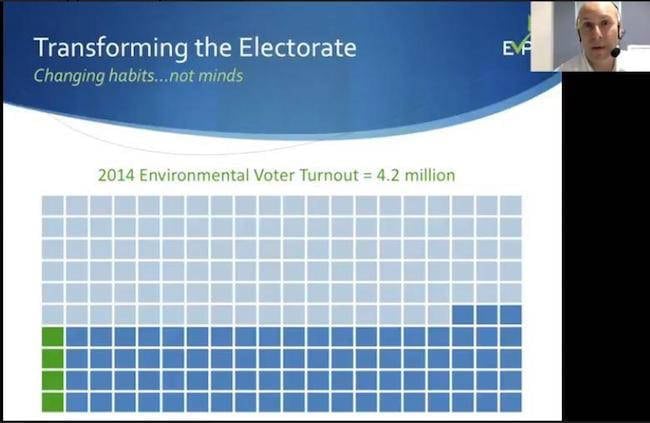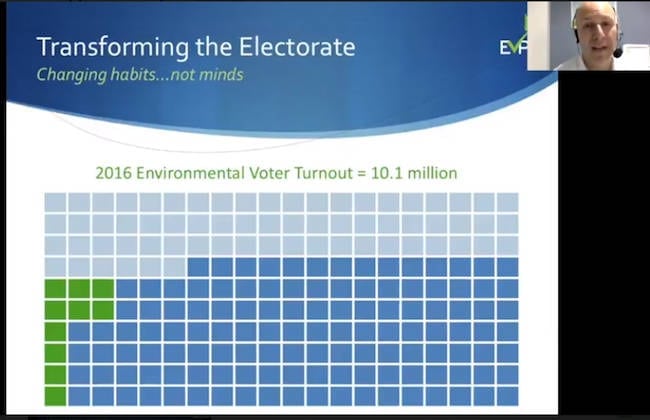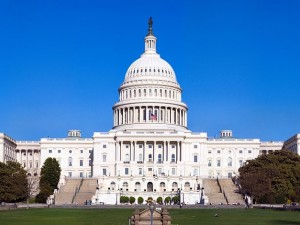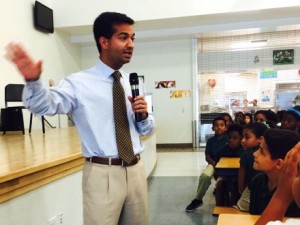By Sara Wanous
Each month, Citizens’ Climate Lobby hosts an online meeting featuring a guest speaker to educate listeners on topics related to climate change and our Carbon Fee and Dividend proposal. Check out recaps of past speakers here.
On our June 2018 national call, we welcomed guest speaker Nathaniel Stinnett, the founder and executive director of the Environmental Voter Project. Like all of us at CCL, Nathaniel is passionate about building the political will for politicians to act on climate change. Unlike most of us, Nathaniel has also been recognized as a “visionary” by The New York Times for his work with the Environmental Voter Project.
The Environmental Voter Project has a simple mission: “Get more environmentalists to vote in every election.” They are focused identifying people who already rank climate change or other environmental issues as one of their top two priorities and getting them out the door on election day. Armed with big data on voting trends and the latest in behavioral science, this nonprofit is targeting the 10.1 million Americans who are already registered to vote and prioritize environmental issues, but don’t vote regularly. They are motivating this targeted population by offering free election reminders to anyone who pledges to vote consistently and prioritize environmental issues and by actively canvassing in Nevada, Colorado, Georgia, Florida, Pennsylvania, and Massachusetts.
By the numbers
At Citizens’ Climate Lobby, we know that politicians respond to the will of their constituents, and we leverage this in our work. Nathaniel points out that the loudest voices are those of voters because “politicians go where the votes are, or they don’t get to be politicians anymore.” This comes with good news and bad news. The good news is that 20.1 million Americans who are registered to vote identify climate change or other environmental issues as one of their top two priorities. These are “super-environmentalists,” as the Environmental Voter Project calls them.
The bad news? “Environmentalists are disproportionately awful voters,” Nathaniel says. Using public voting and polling data, the Environmental Voter Project breaks down the numbers of environmentalists who vote.
In the United States, we have about 200 million registered voters. In the 2014 primaries, 83 million people voted, and of those 83 million, only 4.2 million were super-environmentalists.
In the 2016 presidential election, 137 million of the 200 million possible voters showed up to the polls. Of those 137 million, only 10.1 million were super-environmentalists. That leaves 10 million super-environmentalists who were already registered to vote, but who simply didn’t find the motivation to get to the polls in an election that was decided by 77,000 votes.
The habit-changing business
With this information in hand, the Environmental Voter Project is looking not to convince people that climate change and environmental issues are important, but to get the people that already care about these issues to the polls. Nathaniel explained, “We’re in the habit-changing business, not the mind-changing business.”
They are doing this in three important steps:
- Identification. Data on whether or not you vote and polling data is publicly available. The Environmental Voter Project cross-references these data to identify people who rank climate change or other environmental issues as one of their top two priorities, but aren’t voting consistently.
- Mobilization. In their canvassing and digital outreach, the Environmental Voter Project uses the latest techniques in behavioral science. This means that their messages are always nonpartisan and apolitical. The types of messages they’ve found proven to work are:
– Voter pledges: getting people to promise to vote
– Peer pressure: letting people know how many of their neighbors vote
– Social pressure: reminding people that whether or not they vote is public information - Habit Reinforcement. The Environmental Voter Project plans to regularly check voter files to see which environmentalists vote, and target those who don’t vote until they become consistent, super-voters.
How can you help?
Nathaniel left us with two easy ways to help amplify the voices of the millions of Americans who care about climate change. First, you can sign their voter pledge to “be a consistent voter and always prioritize environmental issues” on their website. You can also simply be a “loud and proud environmental voter,” which will encourage our friends, neighbors and colleagues to express themselves at the voting booth too. Nathaniel reminds us, “We might think we already graduated from 4th grade, but the truth is we’re all still in middle school, and peer pressure works!”
To hear more from Nathaniel, including some Q&A with CCL volunteers, watch the entire June meeting on YouTube or listen to the podcast. Follow the Environmental Voter Project on Facebook and Twitter at @Enviro_Voter and Nathaniel Stinnett at @NCStinn.
Sara Wanous has been the Membership Coordinator at Citizens’ Climate Lobby since January 2018. She has a B.A. in Economics and B.S. in Environmental Science and Policy from Chapman University and is pursuing a masters in Climate Science and Policy at the Scripps Institute of Oceanography.






